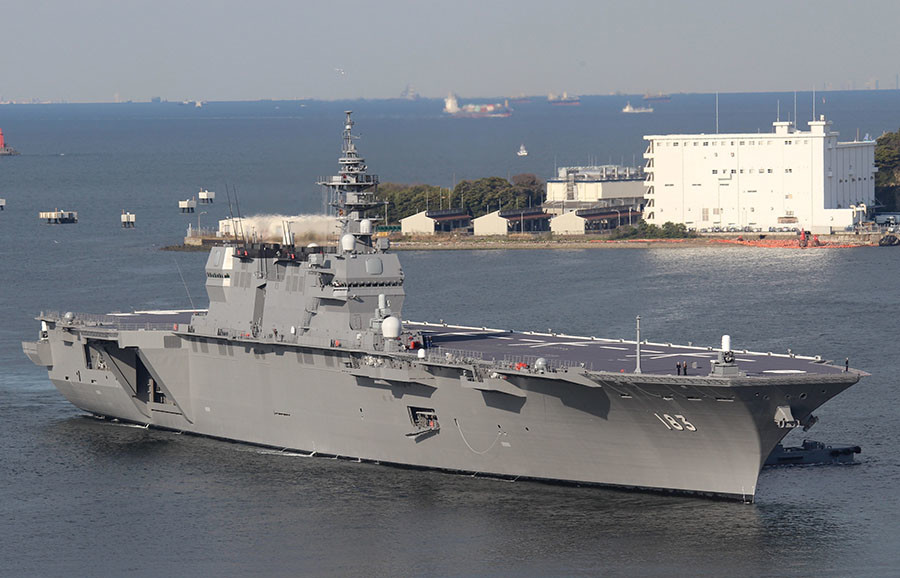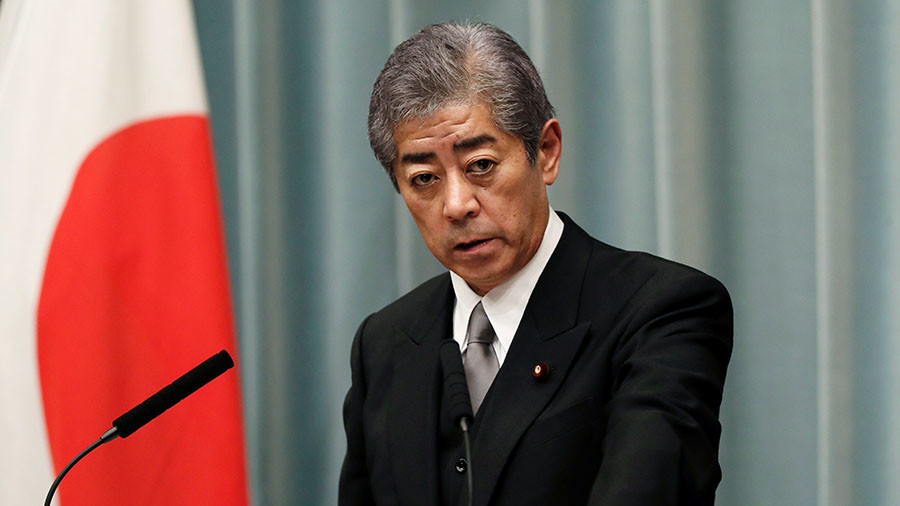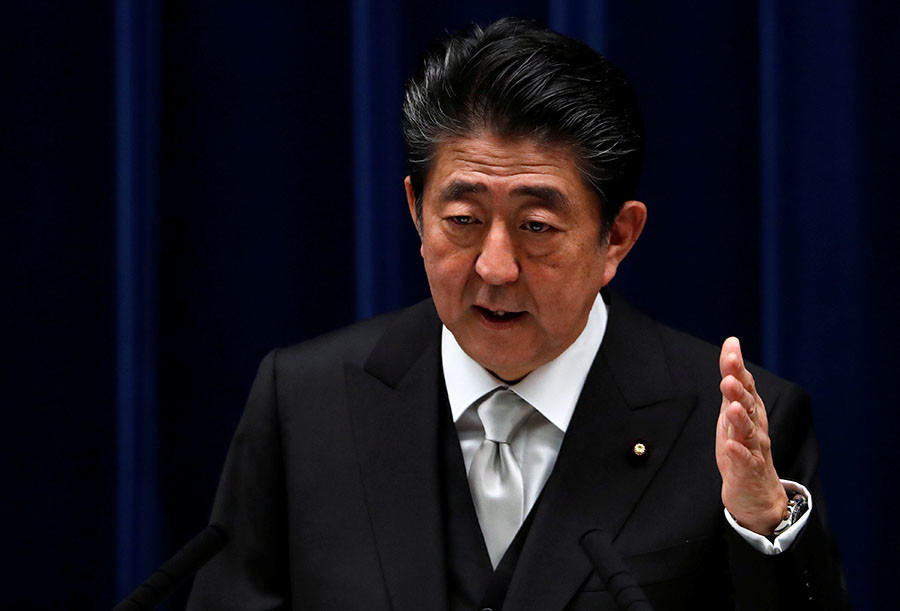Tokyo plans to strengthen the Sea Self-Defense Forces and for the first time since the end of World War II to build its own light aircraft carrier, Japanese media reported. These reports were confirmed by Japanese Defense Minister Takeshi Iwaya. According to him, construction can begin within the framework of the defense budget for 2019, which will be adopted in December.
It is expected that the ship will be available to Japanese sailors already in 2020. We are talking about the modification of the squadron destroyer-helicopter carrier type "Izumo", adopted in the MSS of Japan in 2015. Now the Japanese fleet has two ships of this class. The ship with a displacement of 26 thousand tons can carry on board up to 14 combat helicopters and 470 military personnel. According to preliminary calculations, after the restructuring, the Izumo will become a take-off platform for 10 of the latest fifth-generation F-35B fighters with the possibility of vertical landing and short take-off.
As explained by Takeshi Iwaya, the defense department intends to use the functionality of the available equipment to the maximum, so the ministry will promote the program to create an aircraft carrier.
"Strong military power"
According to experts, at the moment Japan already has a military potential sufficient to force them to reckon with their interests.
As Valeriy Kistanov, head of the Center for Japanese Studies at the Institute of Far Eastern Studies of the Russian Academy of Sciences, noted that the Izumo type ships can be used as aircraft carriers for vertical take-off and without modernization aircraft.

- Izumo helicopter carrier
- © Wikipedia
“Japan is already a strong military power with good naval forces. Shinzo Abe wants to amend the Constitution to finally legitimize the Self-Defense Forces. The decision to build an aircraft carrier is one of many decisions that lie within this philosophy, ”the expert believes.
A similar point of view is held by the leading expert of the Center for Military-Political Studies of MGIMO Mikhail Alexandrov. In a conversation with RT, he explained that Japan possesses the technical and industrial base necessary for the construction of aircraft carriers - the country used them as early as the Second World War.
According to the international research company Global Firepower, Japan is among the top ten military powers along with Britain, Turkey, Germany, France, etc. The Japanese Self-Defense Forces rank seventh in this ranking.
According to estimates of the Russian profile resource “Military Review”, the Japanese navy can claim to be the third largest in the world. At the same time, in compiling the rating, the naval strategic nuclear forces, which Tokyo does not possess, were deliberately bracketed. But the Japanese shipbuilding industry has established a mass production of destroyers equipped with air defense, and can build aircraft carriers - until recently, it was about helicopter carriers.
In addition to the squadron destroyers of the Izumo series, there are two vessels of a similar class, the Hyuga type, launched by IHI Corporation in 2006-2011.
The fleet of the Maritime Self-Defense Forces is often replenished with new ships: in July this year, a new class destroyer was launched in Yokohama, continuing the line of Atago-class ships that entered service about 10 years ago. The new modification of this vessel is equipped with the Aegis combat system, SM-3 Block IIA anti-aircraft missiles, as well as SM-6 antimissiles.
As of last year, the Japanese self-defense naval forces had a total of 43 strike ships, two helicopter carriers, 27 minesweepers and 10 submarines. The Japanese side imports some of the military equipment from the United States, but in many areas of Tokyo they managed to achieve impressive results, relying on their own resources.
For example, although Tokyo does not have nuclear submarines, the Soryu series submarines equipped with an anaerobic power plant are available. Also, the Japanese government refused in its time to buy Poseidon anti-submarine aircraft from the United States. Instead, the Japanese Aircraft Corporation Kawasaki created its own aircraft of this class Kawasaki P-1.

- Japanese Defense Minister Takeshi Iwaya
- Reuters
- © Issei Kato
But the Japanese Cabinet does not spare the funds for the purchase of new weapons of foreign manufacture. As the Japanese edition of the Nikkei Asian Review reported on November 27, Tokyo may enter into a contract for the supply of 142 F-35 fifth-generation fighter-bombers in the foreseeable future. Although initially the Japanese Ministry of Defense was considering the possibility of supplying only 42 aircraft, the government can now revise these plans in light of China’s growing military and political activity, the publication said. The contract value could be $ 9 billion.
The Japanese defense department has the necessary amounts, over the past years, the country's military spending has steadily increased. If in 2016 Japan spent $ 41.7 billion on defense, in 2017 it was already $ 44.64 billion. In 2018, the Ministry of Defense could manage $ 45.7 billion. Next year, the military department expects to receive $ 47.7 billion, corresponding request was previously sent to the Cabinet.
“Moods split equally”
Defeated in World War II, Japan was forced to give up the right to have its own full-fledged army. This principle was enshrined in the constitution adopted by Japan in 1947. Tokyo renounced war as the “sovereign right of the nation,” as well as the threat or use of force to resolve disputes with other states. In accordance with the UN Charter, Japan created the Self-Defense Forces in 1954. However, gradually, Tokyo is moving towards lifting the ban on a full-fledged army.
One of the most active supporters of these plans is the current head of the government, Shinzo Abe - the leader of the Liberal Democratic Party (LDP). The politician already held the post of prime minister in 2006–2007, but was forced to leave his post ahead of schedule. One of the reasons for this decision was the active resistance of the opposition to Abe’s plans to extend Japan’s mission to refuel ships participating in the US military operation in Afghanistan.

- Prime Minister of Japan Shinzo Abe
- Reuters
- © Issei Kato
Political opponents of Abe from the Democratic Party felt that this would violate the basis of the country's law, and the prime minister was unable to convince them. Not everyone liked Abe’s plans to hold a referendum in the country to repeal the “anti-war” article of the Constitution. At the same time, during his first term as Prime Minister, Abe managed to take an important, symbolically important step - to rename the National Defense Administration (DNA) as the Ministry of Defense.
After the Liberal Democratic Party, led by Abe, won the elections in 2012, Tokyo continued efforts to increase the country's military potential. In 2015, parliament approved the expansion of the powers of Japan’s self-defense forces abroad. So, they got the opportunity to take part in operations even in cases when it is not about protecting Japan from military aggression.
Commenting on the bill, Shinzo Abe told reporters that this measure would not only help to protect Japanese citizens, but would also deepen the strategic partnership with Washington.
According to political scientists, Tokyo’s defense ambitions are partly dictated by Pyongyang’s activity. In response to the regular rocket tests of the DPRK, which took place at the beginning of last year, Tokyo said that the National Self-Defense Forces could strike at enemy territory. Earlier this year, it became aware of the creation in Japan of its own units of marines. According to experts, this is a clear sign that the Asian power in the future does not plan to limit itself to the defense of its own borders.
However, as Kistanov notes, not everyone in Japan likes the plans of the current government. Many citizens consider the strengthening of the Self-Defense Forces as not entirely legitimate, because their capabilities have long exceeded defense needs.
“For Shinzo Abe, it will not be easy to make amendments to the basic law, since the final decision will be made in a referendum, and the public’s opinion, divided by opinion polls, was divided approximately equally. For the most part, the Japanese are not eager to turn into a major military power and enter into some kind of conflicts at sea, far from their native shores, ”Kistanov explained in an interview with RT.
"Naval race"
At the same time, Tokyo is not connected with the most rosy relations with some of its neighbors in the region. Even with South Korea, a military alliance partner with the Pentagon, Japan has cause for serious disagreement.
So, Seoul demands that the Japanese side bring a public apology to the Korean people for their crimes committed during the occupation period - from 1910 to 1945.
Historical memory influences relations between the countries so far - as shown by a survey conducted in 2014 by the World Service BBC, 79% of South Koreans negatively perceive Japan. As for the DPRK, the Japanese side is not in a hurry to dismiss the North Korean military threat.
With China, Japan continues perennial territorial disputes. First of all, we are talking about the Senkaku archipelago, which the Chinese call Diaoyu, located in the East China Sea. Beijing and Tokyo are simultaneously claiming to the islands, now this area is under the control of the Japanese side.

- Senkaku Archipelago
- Reuters
- © Kyodo
At the same time, the Spratly archipelago and the Paracel Islands, located in the South China Sea, are now the field of vigorous activity of the PRC and the subject of territorial claims by several states of the region, including Japan. The United States is also involved in a dispute with China - in Washington they say that they are defending "freedom of navigation." As explained by Alexandrov, the United States advocates that Japan also intensify efforts in the area.
"In this case, the Japanese aircraft carrier can be very useful to the Japanese," the expert explained.
“By and large, Tokyo is now engaged in demonstrating force against the PRC. The fact that Tokyo will increase its military potential is counted on by the United States, which is in great need of a strong regional ally, ”Alexandrov explained in a conversation with RT.
At the same time, for Russia, the appearance in service of the Japanese self-defense forces of aircraft carriers does not pose a threat, the expert believes.
“We are so close to Japan, and our defense in the Sea of Okhotsk region, taking into account the Kuril Islands, is so tightly closed in a circle that no enemy will pass through here,” Alexandrov stressed. “Due to the fact that we have airfields on both Sakhalin and the Kuriles, we do not need any aircraft carriers in this region.”
Kistanov agrees that the main potential “target” of the Japanese carrier fleet is China, which also is stepping up the construction of aircraft-carrying vessels.
“There is a real naval race between China and Japan. Of course, in a major war, Japan will not be able to resist China, even assuming that Beijing has nuclear weapons, not to mention quantitative superiority. Therefore, Japan will not give up its alliance with Washington, ”Kistanov concluded.
